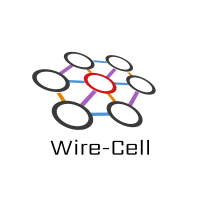Response Refactoring
In WCT we try to follow the mantra "everything is a component". One corollary to that is we try to avoid hard-wiring dependencies by having functionality accessed by hard-wired construction of concrete classes. The various classes having to do with responses suffered from not being available as components. This led to the entire toolkit having hard-wired behavior which hampers support for multiple detectors. This post describes some recent steps to fix this problem.
Survey of Responses
There are various responses that matter in LArTPC. In WCT they include:
- field response
- a waveform giving induced current for a point charge drifting along a path determined by some starting point ("impact position")
- electronics response
- strictly referring to the functional form, parameterized by a gain (in units of Voltage/Charge) and a shaping (peaking) time which gives a voltage waveform when convolved with a charge waveform. This is models the effect of the BNL cold electronics.
- rcrc response
- the RC filters in the MicroBooNE electronics after the cold amplifier.
- plane impact response
- a roll-up of the above and used for
simulation components (
DuctorviaImpactZipper)
Field Response Functions
The field response functions (FR) are a large family of waveforms
defined along many impact positions that span (so far) up to +/- 10
wires on either side of the "wire of interest" and defined at 1/10
pitch positions. These are (currently) calculated by Garfield and
then converted to JSON (see the command wirecell-sigproc
convert-garfield). Because they represent a lot of detailed data in
a rather specific and not so friendly format it is recommended that
users, for the most part, treat these files as "binary blobs".
However, they represent critical data for simulation and signal
processing. They need to be used by many components. In order to
avoid loading and reloading the same files they should not be loaded
directly but rather accessed in components by (you guessed it) another
component. The component interface is IFieldResponse is rather
trivial, providing just one method field_response() which returns a
reference to the top Response::Schema::FieldResponse data structure.
When you need the FR set you should lookup a IFieldResponse
component based on a configuration parameter given to your component:
std::string fr_type_name = ...; // eg, maybe "FieldResponse:InstanceName"
auto ifr = Factory::find_tn(fr_type_name);
auto fr = ifr->field_response();
You can then iterate through planes and wires until getting actual response functions.
Electronics Response
The Electronics Response is a single function giving a waveform
parameterized by gain and shaping time. It has a functional form
defined deep inside wire-cell-util but your component code should
avoid using it directly and instead use an IWaveform component that
provides it. With such a component you can get the waveform sample
vector as well as start time and sampling period.
The ElecResponse component is currently the only one available and
it takes gain and shaping as well as a relative post shaping gain
(postgain). Your component may look up a configured version.
Again, your component should take the instance name to use as a
configuration parameter.
std::string er_type_name = ...;
auto er = Factory::find_tn(er_type_name);
cerr << "Tick is " << er->waveform_period() << endl;
auto spec = dft(er->waveform_samples()); // do FFT
RC Response
The RC response is simply that of an RC circuit. It's parameterized
by a "width" in units of time. It also delegates to a hard-wired
function deep in wire-cell-util and your component code should look
it up just like ER.
Plane Impact Response
The plane impact response (PIR) is a special purpose component which
rolls up the FRs and optionally some number of other responses. It
performs a convolution of each FR function with all the other response
and gives access to the result on a per-impact basis. This component
is primarily used by the signal simulation. It has one implementation
in wire-cell-gen which can be configured with the FR instance name
and a list of instance names for "other" responses. For simulating
MicroBooNE for the "other" response includes one ER and two RCs (of
the same name so that an RC2 response is effected).
Why Refactoring?
So, what's with the refactoring? Well, we used to violate "everything is a component" guideline with all these responses. This started mostly due to laziness in not getting around to making them honest components. But there were some misuse of them as well, particularly with using PIR:
- to get some simple configuration parameters that a component should best be configured directly. (Eg, why get a giant PIR with its dependencies just to know how many ticks to make in a readout?)
- for things that the
Pimposclass can provide (this class deserves its own post, and probably should become a component). - to get at the FRs instead of getting them directly.
Also, given the hard-wiring, we were unable to support different responses as needed to support different detectors (eg, the RC2 is MicroBooNE-specific). This refactoring was needed to break that hard-wiring.
What now
Mostly this refactoring is not a change that users will care about. However, some things may have broken in the near term. There are also now some configuration items that are no longer hard-wired and need to be supplied in configuration. Work is ongoing to improve the official config examples to catch up with these changes. By the next release this will be all sorted.
